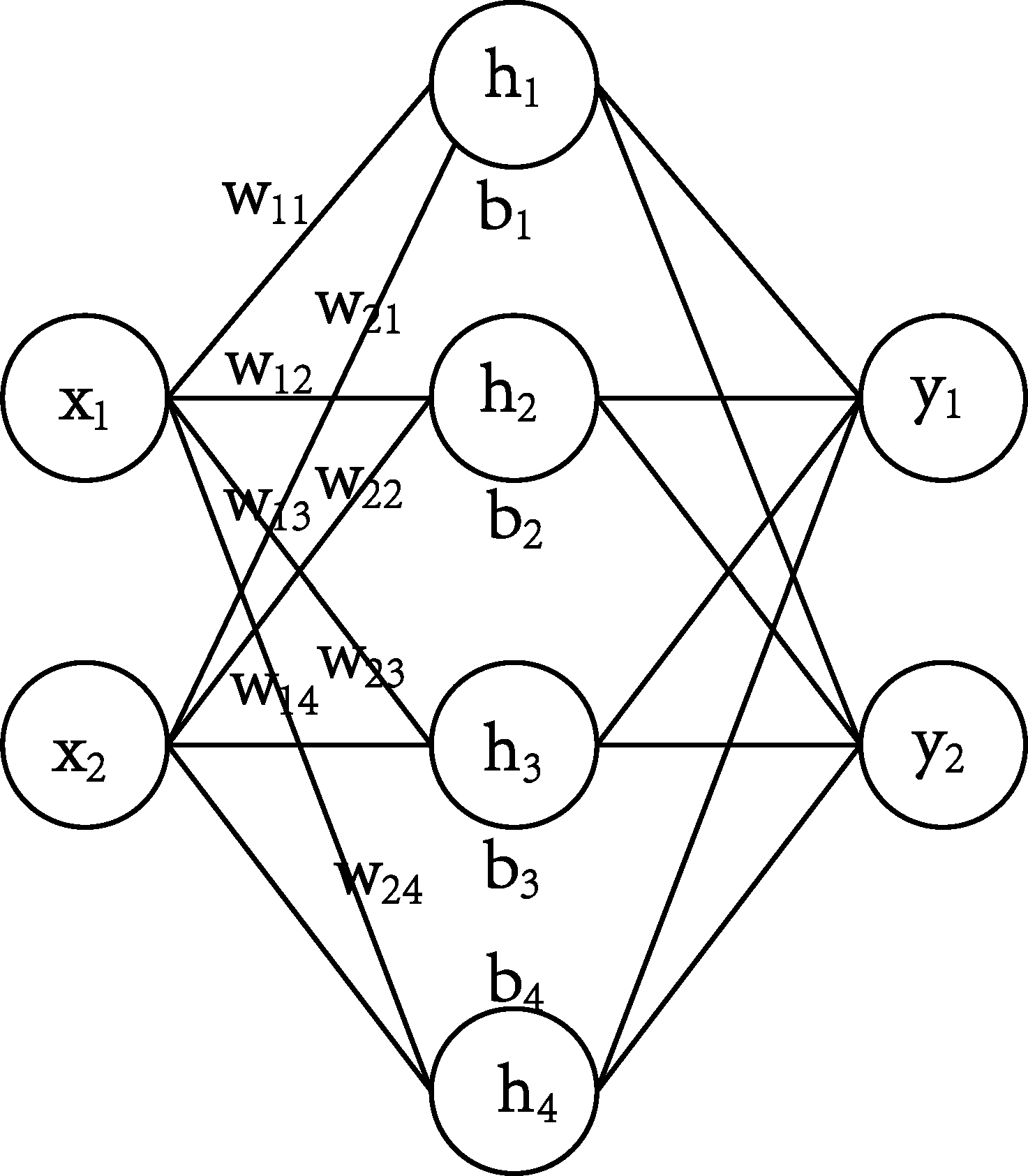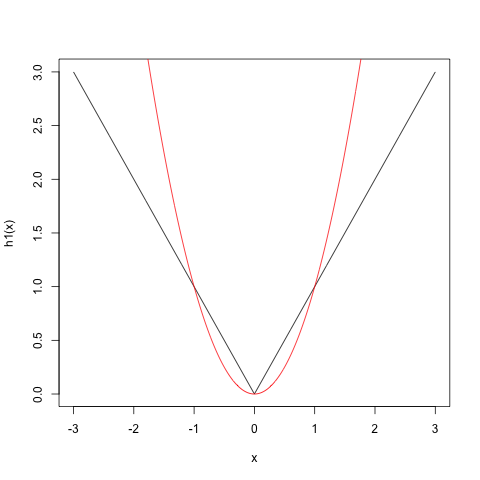激活函数的一些问题
为什么要使用non-linear激活函数不使用linear激活函数?

给定一个如图所示的前馈神经网络。有一个输入层,一个隐藏层,一个输出层。输入是$2$维的,有$4$个隐藏单元,输出是$2$维的。
则:$ \hat{f}(x) = \sigma(w_1x+b_1)w_2 + b_2$
这里$\sigma$是一个线性的激活函数,不妨设$\sigma(x) = x$。
那么就有:
\begin{align*}
\hat{f}(x) &= \sigma(w_1x+b_1)w_2 + b_2\
&= (w_1x+b_1)w_2 + b_2\
&= w_1w_2x + w_2b1 + b_2\
&= (w_1w_2) x + (w_2b1 + b_2)\
&= w’ x + b’
\end{align*}
因此,当使用线性激活函数的时候,我们可以把一个多层感知机模型化简成一个线性模型。当使用线性激活函数时,增加网络的深度没有用,使用线性激活函数的十层感知机和一层感知机没有区别,并不能增加网络的表达能力。因为任意两个仿射函数的组合还是仿射函数。
为什么ReLU激活函数是non-linear的?
ReLU的数学表达形式如下:
$$g(x) = max(0, x)$$
首先考虑一下什么是linear function,什么是non-linear function。在微积分上,平面内的任意一条直线是线性函数,否则就是非线性函数。
考虑这样一个例子,输入数据的维度为$1$,输出数据的维度也为$1$,用$g(ax+b)$表示ReLU激活函数。如果我们使用两个隐藏单元,那么$h_1(x) = g(x)+g(-x)$可以用来表示$f(x)=|x|$,而函数$|x|$是一个非线性函数,函数图像如下所示。

我们还可以用ReLU逼近二次函数$f(x) = x^2$,如使用函数$h_2(x) = g(x) + g(-x) + g(2x-2) + g(2x+2)$逼近二次函数,对应的图像如下。

使用的项越多,最后近似出来的图像也就和我们要逼近的二次函数越像。
同理,可以使用ReLU激活函数去逼近任意非线性函数。
为什么ReLU比sigmod还有tanh激活函数要好?
ReLU收敛的更快,因为梯度更大。
当CNN的层数越来越深的时候,实验表明,使用ReLU的CNN要比使用sigmod或者tanh的CNN训练的更容易,更快收敛。
为什么会这样,目前有两种理论,见参考文献[4]。
第一个,$tanh(x)$有梯度消散问题(vanishing gradient)。当$x$趋向于$\pm\infty$时,$tanh(x)$的导数趋向于$0$。如下图所示。
Vanishing gradients occur when lower layers of a DNN have gradients of nearly 0 because higher layer units are nearly saturated at -1 or 1, the asymptotes of the tanh function. Such vanishing gradients cause slow optimization convergence, and in some cases the final trained network converges to a poor local minimum.
One way ReLUs improve neural networks is by speeding up training. The gradient computation is very simple (either 0 or 1 depending on the sign of x). Also, the computational step of a ReLU is easy: any negative elements are set to 0.0 – no exponentials, no multiplication or division operations.

ReLU是non-saturating nonlinearity的激活函数,sigmod和tanh是saturating nonlinearity激活函数,会将输出挤压到一个区间内。
f是non-saturating 当且仅当$|lim_{z\rightarrow -\infty} f(z)| \rightarrow + \infty$或者$|lim_{z\rightarrow +\infty} f(z)| \rightarrow + \infty$
tanh和sigmod将输入都挤压在某一个很小的区间内,比如(0,1),输入发生很大的变化,经过激活函数以后变化很小,经过好几层之后,基本上就没有差别了。而当网络很深的时候,反向传播主要集中在后几层,而输入层附近的权值没办法好好学习。而对于ReLU来说,任意深度的神经网络,都不存在梯度消失。
第二种理论是说有一些定理能够证明,在某些假设条件下,局部最小就是全局最小。如果使用sigmod或者tanh激活函数的时候,这些假设不能成立,而使用ReLU的话,这些条件就会成立。
为什么发生了梯度消失以后训练结构很差?
我的想法是,
参考文献
1.https://stats.stackexchange.com/a/391971
2.https://stats.stackexchange.com/a/299933
3.https://stats.stackexchange.com/a/141978
4.https://stats.stackexchange.com/a/335972
5.https://stats.stackexchange.com/a/174438
6.https://stats.stackexchange.com/questions/391968/relu-vs-a-linear-activation-function
7.https://stats.stackexchange.com/questions/141960/why-are-rectified-linear-units-considered-non-linear
8.https://stats.stackexchange.com/questions/299915/how-does-the-rectified-linear-unit-relu-activation-function-produce-non-linear
9.https://stats.stackexchange.com/questions/226923/why-do-we-use-relu-in-neural-networks-and-how-do-we-use-it/226927#226927
10.https://www.zhihu.com/question/264163033
11.http://ai.stanford.edu/~amaas/papers/relu_hybrid_icml2013_final.pdf